Complete guide on stainless steel cookware
-
Darrian Wilkins
- Last update: April 21, 2022
Disclaimer: we may receive commissions from purchases made via our links at no cost to you
I love stainless steel cookware.
Stainless steel cookware is one of the most versatile, durable, and hard-working styles of cookware that money can buy.
It combines the durability and strength of cast iron, and the health benefits of ceramic cookware, with the even heating of copper or aluminum pots and pans. And if you put in the effort, you can even feel like you’re using non-stick cookware.
While each genre of cookware performs each ability marginally better than stainless steel, stainless steel is the only genre of cookware that pulls all these positive attributes into one place.
But before we dive into the world of stainless steel cookware, we must first answer the question, “What is stainless steel?”
What is stainless steel?
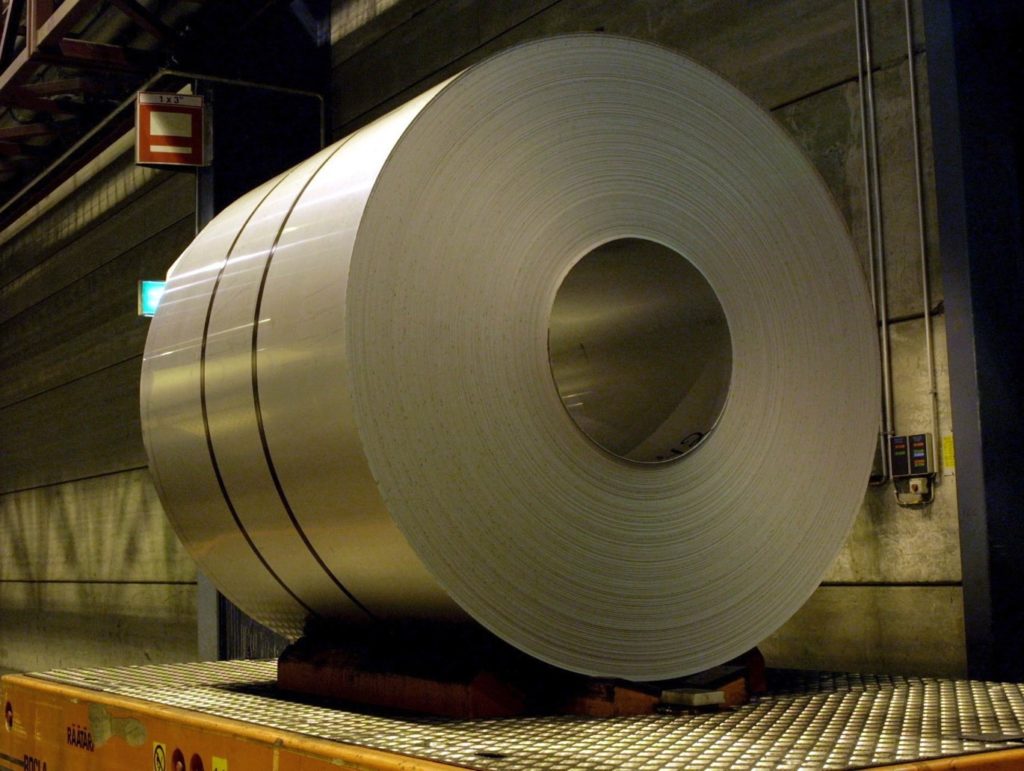
You’ve probably heard the words “Stainless steel” countless times without ever learning what it is. It’s used in the automotive industry, construction, to make cutlery and surgical tools, and of course, cookware (Elon Musk even used it in the construction of his starship).
But what makes this metal so special?
Stainless steel has many beneficial properties that make it the perfect metal for so many industries. Some of the most sought after properties are:
- Extremely Durable & Robust
- Easy to Work With
- Almost Infinitely Recyclable
- Resistant to Rust
- Tolerant of Extreme (both high & low) Temperatures
- High Tensile Strength
- Pleasing Aesthetics
Invented in 1912 by metallurgist Harry Brearly, stainless steel was initially created to increase the longevity of gun barrels and stop them from going rusty. After some initial experimentation, Breary found that adding a layer of chromium to a steel alloy would increase its resistance to acid and oxidation.
He named it “rustless steel.”
After agreeing on a deal with a friend to use his chromium-steel to make cutlery, he changed the compound’s name to “stainless steel.” It became so popular that a company called “Victoria,” who produced knives for the Swiss Army began using the steel in their manufacturing process.
Victoria later changed its name to Victorinox, which is now one of the most famous multitool manufacturers in the world.
The stainless steel composition means that this material (used in hundreds of industries and thousands of products) is durable, scratch and stain-resistant, capable of withstanding super high or bone-chillingly cold temperatures, corrosion-resistant, and looks pretty darn good too.
Stainless steel is an iron and chromium alloy (a metal made by fusing two or more metallic elements), and the chromium element must make up a minimum of 10.5% of the compound. Various other components are used to manufacture different grades of stainless steel. The more common additives used are:
- Carbon
- Copper
- Nitrogen
- Nikel
- Manganese
- Silicon
- Sulfur
- Molybdenum
The content and ratios of each are entirely dependent on the grade of the stainless steel and the intended use of the stainless steel.
Types of stainless steel used in cookware
There are five primary types of stainless steel which I’ve listed below.
- Ferritic Stainless Steel
- Martensitic Stainless Steel
- Austenitic Stainless Steel
- Precipitation-Hardening (PH) Stainless Steel
- Duplex Stainless Steel
Ferritic, Martensitic, and Austenitic are the three types of stainless steels most commonly used to manufacture cookware whose names have been simplified, so they sound less scientific.
There are subsets within these genres that signify varying qualities, durabilities, and temperature resistance of the steels.
200 Series Stainless Steel
The lowest quality stainless steel, 200 series, uses manganese and nitrogen instead of nickel because it’s cheaper and more widely available. While 200 series stainless steel is generally more robust and harder than 300 series, a lower chromium and nickel content reduces the steel’s resistance to corrosion.
This austenitic type of stainless steel is food safe and typically used in low-budget cookware. It’s not magnetic either, so if you have an induction range, avoid pots and pans made from 200 series stainless steel because it’s unlikely that a budget set will have a quality base attached that’s conducive to high-performance.
While this stainless steel type is the lowest quality, it also has the lowest nickel content, which is beneficial for people who have allergies and reactions when exposed to nickel.
300 Series Stainless Steel
The most commonly used grades in premium cookware are found in 300 series stainless steels and the subsets found within.
As far as cookware goes within the 300 series, you’ll primarily find pieces made from either 304 stainless steel or 316 stainless steel. When used for cooking, the differences between 304 and 316 stainless steels are negligible as they were designed to survive in extreme environments, which you won’t find in the kitchen.
304 stainless steel is an austenitic metal that has two other subsets within its category. It can use either 18/10 or 18/8 stainless steel. The numbers represent the percentage of the chromium and nickel content of the alloy, respectively. The amount of chromium and nickel in these stainless steels was chosen with other applications outside the kitchen in mind, and subsequently, you won’t notice the difference in performance.
With a more significant molybdenum content than 304 stainless steel, 316 stainless steel is even more corrosion resistant. But again, this type of metal, when used in cookware, won’t be subjected to environments extreme enough to show the benefits the extra molybdenum holds over 304 stainless steel.
The best stainless steel cookware has a grade of 18/8 or 18/10, which indicates the ideal chromium to nickel ratio for superior corrosion resistance. This grade of stainless steel cookware is durable, won’t rust when dried properly.
400 Series Stainless Steel
Logic dictates that if series 300 stainless steel is better than 200 series stainless steel, then 400 series would be the highest quality of all, right? Wrong.
400 series stainless steel is a ferritic alloy (so it’s magnetic) with an 18/0 chromium/nickel content (though it’s worth noting that while the ‘0’ suggests this steel is nickel-free, there are trace amounts found in the steel).
Magnetic Stainless steel cookware is required for induction stovetops. Choose stainless steel cookware that has a ferritic alloy base to allow conduction with an induction stovetop.
Cookware made from 400 series stainless steel is better for people with nickel allergies, but the pots and pans themselves are less durable and will lose their shine more quickly than those made from the 300 series.
While I’ve covered the basics of stainless steel and the various grades used to manufacture cookware, the Over Engineer does a fantastic job giving a more in-depth look into the large variety of grades you might find in other products.
Best stainless steel grade for cookware
While the 300 series stainless steel is superior to 400 series (200 series is only used in budget products) and more commonly used, the stainless steel used in the cookware is less important than the construction of the products themselves.
Constructions of stainless steel cookware
Now that I’ve covered the various stainless steel used in cookware, it’s time to talk about the different methods brands use to produce their pots and pans. There’s a ton of industry terminology and jargon involved in cookware. Some of it you may be familiar with, and some of it you probably won’t.
While stainless steel is super durable, malleable, and has minimal leaching of chemicals and toxins into your food, it’s not a great conductor of heat.
Cookware brands adopt different manufacturing processes to negate that weakness and improve heat transfer, distribution, and retention while maintaining the cookware’s durability.
Single-Ply Construction
This type of construction is reserved for the cheapest and most basic types of cookware. As the name suggests, pots and pans made with a single-ply construction are made from a solitary layer of stainless steel.
As I’ve already mentioned, stainless steel is a poor conductor of heat, so single-ply pans tend to heat unevenly and have inefficient heat retention. The only benefit of buying single-ply cookware is that it’s very affordable, but it is inferior to other cookware types in every category.
Impact Bonded Construction
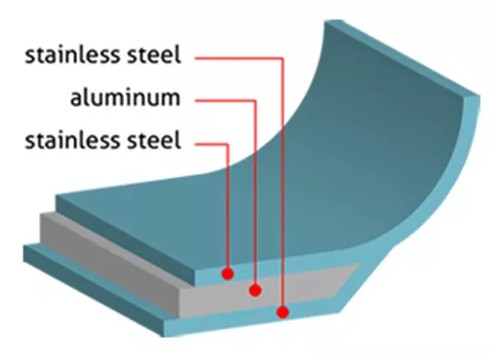 Because single-ply cookware is so inadequate in distributing and retaining heat, manufacturers may use a process called “impact bonding” to add a heavy-gauge aluminum disc to the bottom of the stainless steel pot or pan.
Because single-ply cookware is so inadequate in distributing and retaining heat, manufacturers may use a process called “impact bonding” to add a heavy-gauge aluminum disc to the bottom of the stainless steel pot or pan.
Aluminum has a far superior thermal conductivity of approximately 235 watts per kelvin per meter, whereas stainless steel has around 15 watts per kelvin per meter. In layman’s terms, aluminum has roughly 15 times the thermal conductivity of stainless steel.
Brand’s take their stainless steel cookware and pre-heat them, so they become malleable. Using specialized equipment, the impact bonding machines force the aluminum discs into the cookware using massive amounts of pressure.
“So why not make cookware out of aluminum?”
Good question. Aluminum, while relatively inexpensive, easy to work with, and has an excellent thermal conductivity rating, is lightweight, not very durable, reactive to acidic foods, and unable to endure high temperatures.
You can buy aluminum cookware, but you’ll find it’s typically coated in non-stick or has a hard-anodized exterior … which is a different type of cookware altogether.
While these aluminum discs improve how quickly the cookware gets hot and distributes that heat, these benefits are only available where the aluminum meets the stainless steel. So they’re less effective at heating the sidewalls of a saucepan or stock pot, but they do a good job of heating the bottom of a skillet.
Some unscrupulous brands may refer to their impact-bonded cookware as “multi-clad” to deceive the consumer into believing that their pots and pans are of better quality than they actually are.
Tri-Ply Construction
In 1971, renowned metallurgist John Ulam founded the premium cookware company, All-Clad, after incorporating his patented metal bonding techniques that he’d invented in his time as a product engineer into pieces of cookware. All-Clad introduced both tri-ply and five-play cookware and became the pioneers of the cookware industry.
The American company held the patents for cladded cookware from the early 70s until 2004, when other companies became able to produce their own versions of tri-play and five-ply pots and pans.
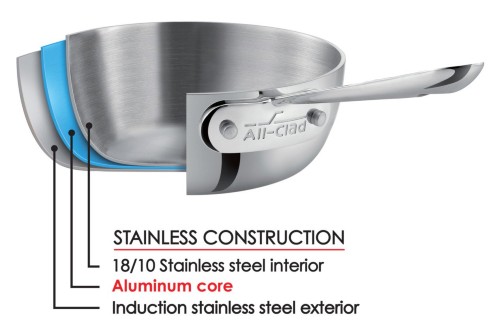 As the name suggests, tri-ply cookware is made up of three layers. This type of cookware is formed by bonding three layers of metal together; usually, an aluminum core (which provides better heat distribution and heat retention and eliminates hot spots and cold spots more efficiently) is surrounded by an interior and exterior layer of stainless steel.
As the name suggests, tri-ply cookware is made up of three layers. This type of cookware is formed by bonding three layers of metal together; usually, an aluminum core (which provides better heat distribution and heat retention and eliminates hot spots and cold spots more efficiently) is surrounded by an interior and exterior layer of stainless steel.
Some brands use copper for an internal or external layer, but I’m focusing on stainless steel cookware in this article.
Producing cookware in this way allows the pots and pans to negate the weaknesses of aluminum (poor durability and leeches metal into food) while combining the strengths of stainless steel and aluminum.
Premium brands incorporate 18/10 stainless steel, an aluminum core, and a 18/0 (magnetic stainless steel exterior). These high-end pieces of cookware exhibit all the sought-after qualities and are magnetic, so they work on induction ranges and cooktops.
Five-Ply Construction
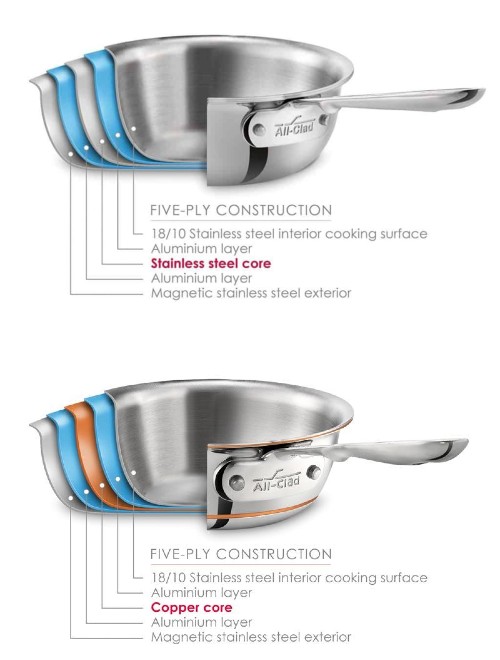 Five-Ply stainless steel cookware aims to go that one step further and adds two additional layers of metal. You’ll typically find that 5-ply cookware has two additional layers of aluminum surrounding the central core to further improve the thermal conductivity of the cookware.
Five-Ply stainless steel cookware aims to go that one step further and adds two additional layers of metal. You’ll typically find that 5-ply cookware has two additional layers of aluminum surrounding the central core to further improve the thermal conductivity of the cookware.
However, some brands use copper as a central core, and this type of cookware is generally more expensive.
Using copper is beneficial because of its thermal conductivity effects, which exceed even the levels of aluminum. With the exception of silver, copper has the highest thermal conductivity rating of any metal with 386 watts per kelvin per meter. Copper is far cheaper than silver, so it’s the most cost-effective metal to use alongside stainless steel and aluminum.
Like Tri-Ply cookware, most brands use either 18/10 or 18/8 stainless steel, with the more high-end pans using magnetic alloys for induction compatibility. Because this type of cookware has two extra layers of metal, it’s more robust than Tr-Ply (all things being equal), but it’s heavier and takes longer to heat. So, it’s your personal preference as to which model you like the most.
Five-Ply and Tri-Ply are widely considered the best type of stainless steel cookware.
Five – Ply Cookware combining stainless steel, 3 successive layers of aluminum, and an exterior layer of ferritic stainless steel, is an affordable choice for long-lasting cookware. Although not as quick to heat and cool as a copper ply cookware. Its durability, heat retaining properties and affordability make this an ideal choice for commercial kitchen environments.
Personally, why would you purchase cookware that is cheap, regularly replaced and ruins your food when used. A home kitchen does not need to have a large assortment of cookware, I would choose only four items for a home kitchen. A 24cm round frying pan with lid, a 2.5L Round Saucepan with Lid, A 5-6L Stock Pot and a 25 cm sauté pan with lid. For as little as $500 you can equip your home kitchen with the highest of quality stainless steel cookware, offering a lifetime warranty and an enjoyable cooking experience.

Seven-Ply
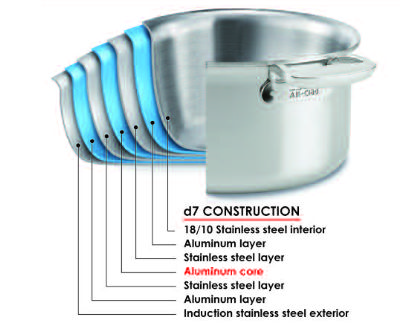 Seven-Ply cookware is produced in pretty much the same way as Tri-Ply and Five-Ply cookware. Stainless steel makes out the exterior (usually magnetic because they’re generally high-end) and interior layer with a mix of copper, aluminum, and stainless steel, making up the five internal layers. Different brands use different metals throughout the constructions.
Seven-Ply cookware is produced in pretty much the same way as Tri-Ply and Five-Ply cookware. Stainless steel makes out the exterior (usually magnetic because they’re generally high-end) and interior layer with a mix of copper, aluminum, and stainless steel, making up the five internal layers. Different brands use different metals throughout the constructions.
If you’re familiar with ‘the law of diminishing returns, you’ll know that there comes the point where the increase of benefits decreases exponentially the more you increase an input.
For instance, while three and five-layered cookware is clearly more beneficial than one, a pan with seven-ply construction is marginally less effective than its smaller counterparts. This is because the thickness of the cookware (again, all things being equal) increases the weight of the piece, and the thermal conductivity rating reduces.
The increase in durability and performance is negligible (if not non-existent), yet this type of cookware is typically more expensive because of the extra materials and man-hours that go into producing it.
Legendary cookware brand, All-Clad created a video taking an in-depth look at the production process of their 5-ply saute pan. While tri-ply cookware doesn’t have the additional layers of copper, the production process is essentially the same.
Note About Tri-Ply, Five-Ply, and Seven-Ply Cookware
I’ve used the phrase “all things being equal” throughout the construction category of this article because not all brands use the same layers of the same thickness. For instance, it’s entirely possible to have a tri-ply and a five-ply skillet with sidewalls of the same thickness.
For instance, if a brand made tri-ply cookware with a thickness of 2.5mm it would be superior to five-ply cookware that was 2mm thick because it would be more robust and can better distribute the heat throughout the pan. Thicker cookware is less likely to have hotspots than thinner pots and pans.
Though many people say “the thicker the better” when it comes to cookware, this is not strictly true. Cookware that is too thick can take much longer to heat and is challenging to handle because of the additional weight.
The sweet-spot for cookware thickness lies between 2.5mm and 3mm.
For good quality stainless steel cookware, in-home, and commercial settings, select five-ply cookware. Look to buy pots or pans which have a thickness of over 2.5mm, have an interior of 18/10 stainless steel. Choose cookware that has stainless steel riveted oven-proof handles and a polished exterior finish for an attractive appearance.

Handles
You might not give much thought to the types of handle on the stainless steel cookware you’re considering purchasing, but there’s more to this part of the cookware than you might realize.
The most crucial factor to consider when looking at cookware handles is how they’re fixed to the pot or pan. Large pieces of cookware filled with food can be extremely heavy, and cheap pans with poor handles can break. At best, your meal is ruined, and at worst, you could suffer a severe burn.
There are two ways of fixing a handle to a pot or pan.
Welded Handles
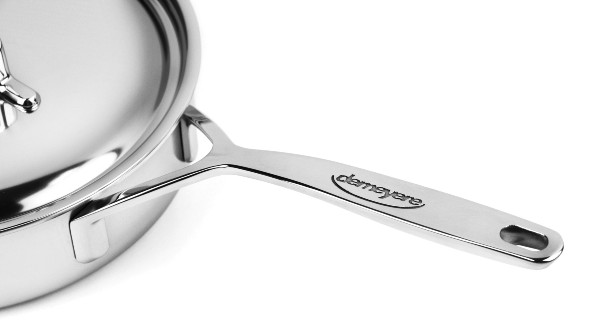
Welding a handle onto a pan is the cheapest way to fix it in place. Unfortunately, it’s also the least effective method. At the same time, the durability of the weld is directly linked to the quality of the person welding it.
Welded handles are more commonly found on budget pieces of cookware, and while it’s unlikely that they will fall off, it’s not beyond the realms of possibility. While any premium cookware with welded handles is extremely unlikely to fail, it is worth considering.
Riveted Handles
Handles held in place with rivets are much sturdier, and the chance of failure is minimal. The rivets are crushed into place by a high-pressure machine making it highly unlikely that they will ever come loose.
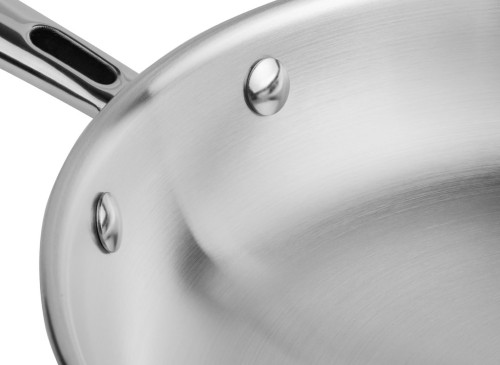 However, because these rivets protrude from the inside of the pan, they often get bits of food stuck in them, and they can be a pain to clean or unhygienic if you don’t keep on top of their cleanliness.
However, because these rivets protrude from the inside of the pan, they often get bits of food stuck in them, and they can be a pain to clean or unhygienic if you don’t keep on top of their cleanliness.
How the handles are attached isn’t the only thing to consider when looking at cookware. Stainless steel handles have a couple of ways of staying cool to the touch.
As I’ve already mentioned, untreated stainless steel is a relatively poor conductor of heat, so that the handles won’t get overly hot on their own anyway. However, brands employ a couple of methods to make sure you can pick up the cookware at any point without burning your hand.
In some cases, brands might fix silicone pads to the handles, completely removing any residual heat that may radiate from the pan.
These handles are comfortable to hold; however, they render the cookware not oven-safe as the handles would melt while cooking.
Another cooling method is usually found in cookware with riveted handles. Where the handle meets the pan (and where the rivets are placed), the fabricated piece of metal will have a hole cut out (usually triangular). With a smaller surface area in direct contact with the hot stainless steel pan, less heat is transferred to the handle, and thus it stays much cooler.
Recommended heat sources
It’s important to consider the primary heat source you have in your kitchen before buying any stainless steel cookware. Though all heat sources are compatible with stainless steel in one form or another, not all stainless steel cookware is compatible with all heat sources.
Listed below are the various heat sources and how stainless steel cookware performs with each one.
Gas
 Generally, stainless steel cookware is most effective on any type of cooker or range with an open flame. The pan’s construction will positively or negatively impact how quickly the pots and pans heat, how evenly it heats, and its efficiency in retaining that heat it has absorbed.
Generally, stainless steel cookware is most effective on any type of cooker or range with an open flame. The pan’s construction will positively or negatively impact how quickly the pots and pans heat, how evenly it heats, and its efficiency in retaining that heat it has absorbed.
No matter the quality, construction, or style of your cookware, they will function on gas cookers and ranges.
Electric/Glass Top
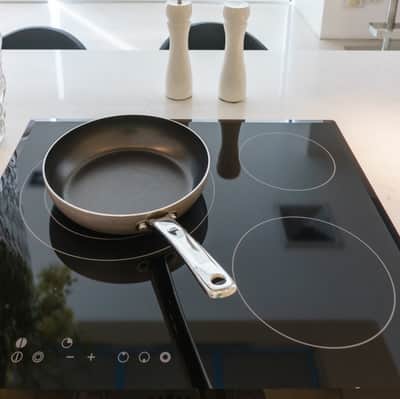 Electric and glass top cookers (essentially the same thing) are generally considered to be one of the least effective types of ranges. Electricity passes through the coils on the hobs and gradually increases the heat of the coil.
Electric and glass top cookers (essentially the same thing) are generally considered to be one of the least effective types of ranges. Electricity passes through the coils on the hobs and gradually increases the heat of the coil.
Because electric cookers use thermal conduction transfer as their primary heating method, all stainless steel cookware, just as using a gas heat source for cooking with stainless steel, depends on the quality of the pan for optimal efficiency. The same can be said cooking on an electric stove.
However, electric cookers are notoriously slow to heat up and can be erratic and heat unevenly. Using a lower quality pan on an electric stove can exacerbate how unevenly a poor quality pan already heats.
Induction
Unlike gas and electric cookers, not all stainless steel cookware works on an induction stove or range.
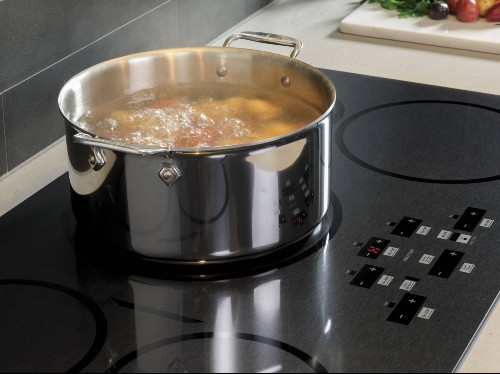 Induction cooktops pass an electric current through copper coils to create an electromagnetic field of energy. That in of itself will not produce a change in temperature with which to cook. It’s not until a magnetic alloy comes into contact with the induction top that the magic (science) starts to happen.
Induction cooktops pass an electric current through copper coils to create an electromagnetic field of energy. That in of itself will not produce a change in temperature with which to cook. It’s not until a magnetic alloy comes into contact with the induction top that the magic (science) starts to happen.
With a magnetic alloy in contact with the cooktop, the electromagnetic energy passes into the cookware. It causes the iron molecules to vibrate up to ten thousand times a second, creating friction and heat, which then transfers to your food. This cooking method created an extremely even heat source and, coupled with a premium quality pan, can produce excellent results.
Because cooking with an induction cooktop requires a magnetic connection, not all stainless steel pans will work. In fact, non-magnetic stainless steel cookware won’t increase in temperature at all when used in conjunction with an induction range. Only cookware that uses stainless steel with some iron content will work with an induction heat source.
If you own an induction cooker, it’s vital to check that the stainless steel cookware you want to buy is suitable. Either check the manufacturer’s website, ask at the store, or test the bottom of the pan with a magnet (my favorite method). The stronger the magnetic pull, the more effective the cookware will be.
Is stainless steel cookware healthy?
With the evolution of non-stick cookware and all the toxicity problems that come with it, many consumers have begun to question the relative safety of other genres of products.
Stainless steel cookware is, by and large, one of the safest types of cookware you can buy (with the possible exception of 100% ceramic cookware). As stainless steel is very durable, there’s little risk of the surface of the pots and pans breaking free and contaminating your food.
While aluminum can leach into ingredients and is often used in the production of stainless steel cookware, it rarely (if ever) comes into direct contact with food as it forms part of the central core. Humans naturally consume between seven and nine milligrams of aluminum per day through the use of canned foods, cooking utensils, and storage containers. In contrast, the recent concerns of links between aluminum consumption and Alzheimer’s have proved unfounded.
Stainless steel on its own poses zero health risks to humans; however, stainless steel cookware often has a nickel component that increases the corrosion resistance of the pots and pans. Approximately 10% of Americans have an allergy to nickel, and using stainless steel cookware with high nickel content can cause some discomfort to sufferers.
Though a nickel allergy is not a serious condition, it’s best to check the nickel content of the stainless steel cookware you want to buy to make sure you don’t end up with itchy red skin or headaches after every meal.
If you have very mild nickel allergies, 18/8 stainless steel should be ok, but if you have a severe allergic reaction or you’re unsure, there are some nickel-free stainless steel cookware sets on the market for you to consider.
Always consult your physician before deciding, and don’t randomly accept medical advice from strangers on the internet.
Stainless steel cookware is chosen by chefs because it provides hygienic protection and food safety. It is nonporous, making it impossible for bacteria and viruses to grow on the surface. And stainless steel does not leach any harmful chemicals or add any extra unwanted flavors when heated. The chromium oxide protective layer of stainless steel cookware makes it non-corrosive and non-reactive. Making perfect for cooking reactive and acidic foods. And it will not rust if dried properly. Stainless is also perfect for serving. Stainless steel is perfect for buffet lines and hot services as it is a good heat insulator.

Recommended utensils
Like almost everything in your kitchen, there is a wide variety of styles of kitchen utensils, all with varying pros and cons. You might favor one type over another, or you might like to mix and match, so you always have the right tool for the job.
But how will your stainless steel cookware react with different utensils? There are four primary utensils types, silicone, wood, coated metal, and uncoated metal.
Silicone Kitchen Utensils
Silicone kitchen utensils are the most widely available and affordable style of kitchen utensils. Thanks to silicone’s soft and pliable nature, these utensils are among the safest to use with stainless steel cookware. You won’t scratch the pots and pan’s surface, and the wear and tear will be minimal.
However, because silicone is so flexible, these types of utensils are not always the right tool for the job, especially if you’re cooking dense or heavy food. There’s also a debate about the eco-friendlies of silicone. While silicone is derived from sand, there are other chemicals within the polymer that, while better than plastic, is not as eco-friendly as wood or metal.
Wooden Kitchen Utensils
Wooden tools are old school. Your grandparents probably had a huge variety of wooden kitchen utensils, and with good reason. Wood is the ultimate eco-friendly kitchen utensil. They’re a lot more rigid than silicone utensils yet still won’t damage the surface of stainless steel cookware.
While wooden utensils are very poor conductors of the high temperatures that stainless steel can reach (which is great for safety), they can easily stain, are challenging to clean, and absorb odors. While wooden kitchen tools are excellent for use with stainless steel, their usefulness is limited as they tend to be quite thick.
Silicone Coated Metal Kitchen Utensils
Like cladded stainless steel cookware, silicone-coated metal kitchen utensils combine two different materials to utilize their beneficial properties. The metal core of the tools provides rigidity and sturdiness, while the silicone outer layer protects the cookware from damage.
Like regular silicone kitchen utensils, silicone-coated metal utensils are perfectly safe to use with stainless steel cookware.
Metal Kitchen Utensils
Metal kitchen utensils are more commonly used for flipping and turning your food while it cooks as the tools can be pretty thin yet sturdy, so you can get under your food without destroying its integrity.
Unfortunately, the edges of metal utensils can be a bit rough (especially among cheaper products), which isn’t ideal. While using metal kitchen utensils occasionally with your stainless steel cookware won’t be an issue, prolonged use can adversely affect your pots and pans.
If you use metal utensils continuously, the abrasive edges will likely damage the surface of your cookware and cause unsightly scratches on the polished surfaces. However, this wear and tear won’t negatively impact the performance of your cookware, only the aesthetics.
So, if you don’t mind a few battle scars on your skillet or saute pan, then you can use metal utensils with reckless abandon, but if you want to preserve the polished finish of your stainless steel pan, then use these types of utensils sparingly.
Making stainless steel cookware stick less
Stainless steel, as I’ve discussed, is much healthier for the human body, but unfortunately, the non-stick properties are not as effective as they are with the PTFE-coated cousins because it’s impossible to get the pan’s base as smooth as a Teflon pan in the manufacturing process.
While a brand new stainless steel cookware might have decent non-stick properties (when used correctly) as you clean your stainless steel pots and pans, microscopic grooves form in the base of the cookware, and it gives food particles a place to hold on to while you’re cooking.
The more your food sticks, the more forcefully you’ll need to clean your pan, and the more prominent these grooves will become, and, you’ve guessed it, the more food will stick to your pan. It’s a vicious circle.
But with a few tips and tricks, you can improve the non-stick properties of your stainless steel cookware, which in turn will make them more fun to cook with, make them easier to clean and increase the longevity of your pots and pans.
Preheat Your Pan
When stainless steel gets hot, it expands, and the steel’s expansion closes the pores and gives food fewer places to grab on to, and it results in less burnt mess at the bottom of your pan.
There’s a simple test (known as the mercury ball test), so you know when your pan is hot enough. When you think your pan is hot enough, add a small amount of water. If one or two beads form and start “dancing” around the pan, it’s at the perfect temperature.
If the water evaporates rapidly and forms minuscule droplets, the pan is not quite hot enough, so you must continue to preheat. If the water quickly disperses and creates ten or more smaller beads that fire off in different directions, then your cookware is too hot. Reduce the temperature until you have only one or two beads.
When your skillet is at the right temperature, add your oil. NEVER add water to a pan that already has hot oil in it.
Let Your Food Rest
It’s essential to leave your food to rest for 15 minutes to half an hour to bring it up to room temperature before adding it to a hot pan.
Placing cold meat directly from the refrigerator will instantly lower the temperature of the cookware you’ve preheated and cause it to stick. Additionally, your meat will end up being cooked unevenly.
Season Your Stainless Steel Cookware
That’s right! Cookware seasoning isn’t only for cast iron skillets. Correctly seasoning your pan before cooking can drastically reduce the amount of sticking you encounter.
While it’ll never be as effective as traditional non-stick cookware, your life will be made a whole lot easier while avoiding the health concerns that accompany Teflon pans.
Here’s how you do it.
- Choose a cooking oil with a high smoke point. Ghee (480F), vegetable oil (400F), and canola oil (400F) are the best, but extra-virgin olive oil (375F) and lard (370F) are adequate replacements.
- Place your stainless steel pan on the stove and turn it on a high heat. Add a small amount of your chosen fat/oil and take a couple of sheets of absorbent kitchen towel and smear the fat around the bottom of the pan in a circular motion.
- With the fat/oil distributed evenly around the cookware, leave the pan to heat on the stove until the fat/oil starts to smoke slightly. As soon as you see smoke, remove the pan from the range, turn off your heat source, and leave it to cool completely.
- Once your pan is cool to the touch, take another piece of kitchen paper and gently wipe any excess oil/fat that may be left on the bottom.
- Repeat the process four or five times until the bottom of the pan is silky-smooth. Cooking with this piece of cookware should be a doddle from here on in if you follow the guidelines as set out above.
If you’ve seasoned your cookware correctly, you should be able to clean it by wiping it with a piece of kitchen paper. If you have to wash your pan with soap, it will destroy the seasoning, and you’ll have to start all over again.
The fear of many home cooks when using Stainless steel cookware is food sticks to it when they use them for cooking. Much of this fear is generated by the misuse of the pan, not the pan itself (that is unless you have purchased a cheap pan – yes, thin stainless steel is useless to cook with). Without correct use, any equipment is bound to fail. Here are a few tips and techniques to ensure you get the most out of your stainless steel cookware.
Make sure the surface of your pan is clean, a dirty pan with left-over food still on the surface is bound to burn, and make anything you cook on it stick. So thoroughly clean and wipe your pan between usage.
Correct heating of your pan is paramount to ensure food won't stick. So ensure your pan is set to the right temperature before adding food. The best way to ensure your pan is hot enough depends upon the cooking method you are using to prepare your food. A surface thermometer is an indispensable device for any kitchen. To ensure your pan is at the right temperature, place your pan on the heat and place your surface thermometer in the center of the pan.
- 170 C High Heat: For Searing, Sautéing and Boiling
- 135 C Medium: For Sauces, Soups, Low Boil
- 90 C Low: For Simmering, Poaching
Once the desired temperature has been reached, you’re ready to cook. Add high-temperature oil ( never use low-temperature oils as they can burn), such as canola oil, avocado oil, and sunflower oil to your pan, and immediately add the food, there is no need to heat the oil, but don’t let it sit too long before adding food, as the oil can leach and become viscous and cause food to stick to the surface of the pan. And don’t use cooking sprays on stainless steel cookware. Cooking sprays contain chemical propellants and emulsifiers, these additives tend to create a sticky layer on stainless steel, and are very difficult to remove.
Ensure food is free of moisture and has been brought up to room temperature before adding to the pan. Any water or cold food will lower the temperature of the oil and cause food to stick to the pan. Don’t overcrowd the pan, adding too much to the pan will also lower the temperature of the pan, and cause the food to release water causing it to stick to the pan.
And listen for the sizzle, common mistakes with cooking on stainless steel cookware is the micropores of the stainless steel surface when heated, allows food to cling and stick to the pan. When you add food to the pan, any moisture in the food will cause the oil to sizzle and pop. When the food stops sizzling it's time to turn or remove from the pan. The pan will have browned the surface of the food, and be ready to release the food from the surface.

Best foods to cook
It’s always good to have several different cooking weapons in your arsenal, as different cookware genres are more proficient at cooking different kinds of foods. In this section, I’m going to look at which types of foods are the best for cooking in stainless steel pots and pans.
Because stainless steel has such a poor thermal conductivity rating, this type of pan works best when you’re cooking dry foods (Unless, of course, you’re cooking a stew or boiling veg in a stock pot or making sauces in a saute pan). Cold, wet food brings down the temperature of the cookware, making it less efficient.
The types of food stainless steel excel at varies from pan to pan, so here’s a look at the best foods for each pan type.
Stainless Steel Skillet
- Stir Fry – Cooking a crunchy stir fry in a stainless steel skillet is a breeze. Especially if you let your vegetables dry first. You’ll get a golden brown texture.
- Steak – A stainless steel skillet is ideal for searing cuts of meat. The high temperatures you can use coupled with the even heating are perfect for some juicy steak.
Stainless Steel Saute Pan
- Sauces – Stainless steel saute pans are the kings of making sauce, especially those with acidic ingredients. Stainless steel is non-reactive to the sauce, won’t damage your pan, and your pan won’t compromise the flavor of your sauce.
- Toad in the Hole – A stainless steel saute pan (assuming it’s oven safe) can go from hob to range in a blink of an eye. And the taller, vertical walls make it an excellent choice for cooking a golden brown toad in the hole.
- Searing Meat – Like a skillet, a stainless steel saute pan is an excellent choice for sear meat of any kind. You can finish cooking your steak in the oven with minimal fuss.
Stainless Steel Saucepans
- Soup – A three-ply or five-ply stainless steel saucepan is an excellent tool to cook small batches of soup with. Because the central aluminum (or copper) core goes all the way up the sidewalls of the cookware, the saucepan will cook the soup quickly and evenly.
- Small Portions of Pasta – Like cooking soup, boiling small portions of pasta in a stainless steel saucepan is quick and efficient thanks to the even heating and cladded sidewalls of this cookware.
- Boiled Vegetables – Boiling vegetables without your cookware leaching toxins into the water or contaminating the taste of your food is an enormous benefit of cooking with stainless steel saucepans.
Stainless Steel Stock Pot
- Stews – Cooking large quantities of stew in a stainless steel stock pot is incredibly easy and yields excellent results. At low temperatures, the stainless steel construction still maintains an even temperature all the way up the exceedingly high sidewalls.
- Chili – Chili is not too dissimilar to stew in the way that you’ll often want to cook large batches, and the even heating of the sidewalls is perfect for slow-cooked chili.
- Pulled Pork – You can use smaller stainless steel stock pots as a dutch oven to cook pulled pork that literally falls apart. Succulent, juicy, and tender, the stainless steel stock pot will function just as well inside your oven as it does on top of the stove.
Things to avoid when using cookware
Here are a few things to avoid when cooking with stainless steel cookware to help increase the longevity of your cookware.
- Never Use a Knife to Cut Food Inside the Pan: Cutting food with a knife inside the pan will create grooves on the base that food will stick to when you’re cooking in the future.
- Don’t Heat Oil Past Its Smoke Point: Aside from making your kitchen very smokey (and possibly setting off a smoke alarm), heating fat or oil past its smoke point will cause yellowish stains on your cookware which look unsightly and are super tricky to get off.
- Don’t Add Salt to Cold Water: Seasoning your ingredients improves the flavor of your food, but wait until the water is hot. Adding salt to cold water lets the salt grains sink straight to the bottom and can cause “pitting” to the surface of your cookware.
- Never Put a Hot Pan Into Cold Water: Submerging a red hot pan in cold water is one of the worst things you could do to your cookware. The thermic shock caused by the sudden temperature decrease could warp your cookware and compromise the integrity of the stainless steel.
- Avoid Using Cooking Sprays – Cooking sprays are a more convenient way to cook your food and prevent it from sticking to your pan. However, they don’t only contain oil/fat; they have a bunch of nasty ingredients that can gunk up your pan and be super tricky to remove. Stick to traditional oil or fat.
Cleaning
Even though stainless steel cookware is super-durable, there are some essential cleaning tips you’ll want to follow to increase the longevity of your pots and pans and make them easier to cook with in the future.
As I discussed earlier, vigorous cleaning opens up microscopic grooves in the cookware base and gives something to hold on to. While the damage might not be visible to the naked eye, you’ll be able to see when the food adheres to it.
With a bit of care and attention, you’ll improve everything about this type of cookware.
Most stainless steel cookware sets are dishwasher safe; however, I prefer to wash them by hand for optimal cleaning. Here’s how I do it.
- Wipe out any excess fat or food particles with some kitchen paper.
- Deglaze the pan by adding some hot water. Make loose any stubborn stuck on pieces with a non-abrasive long handled dish brush.
- Use a scouring pad or sponge along with some dish soap (don’t use dish soap if you like to season your stainless steel skillet) to clean the pan in a curricular motion. Avoid using steel wool as it’ll damage the bottom of the pan.
- For scorched pans, fill the pan up with hot water until the scorched area is covered and add a generous amount of baking soda. Don’t be afraid to be a little heavy-handed with the baking soda. Let the mixture sit for fifteen minutes before going to work with a scouring pad.
- For extremely difficult stains, add some baking soda to the bottom of the pan and cover with a cup of hot water. Then boil the mixture until the water has all but evaporated. You should be able to remove the stains with a dish brush or scouring pad. If you want to keep your stainless steel cookware looking like new, consider using a stainless steel cleaner like “Bar Keeper’s Friend” for a little extra shine.
Storing
Many people choose to store their stainless steel cookware by stacking the pots and pans inside one another as it’s a good space saver, which is beneficial if you have limited kitchen space.
However, you should avoid doing this at all costs (I would add this to the “Things to Avoid” category but felt it needed a subsection of its own). The constant banging and rubbing together of stainless steel pans will gradually wear down the cookware’s surface and decrease the pan’s effectiveness. Not to mention contributing to the sticking issues I’ve already talked about.
Instead (if space allows for it), consider using a dedicated pot rack where each piece of cookware can sit on its own independently from the other pots and pans. Alternatively, hang your cookware up to avoid unnecessary damage if you have space on the wall or above a window.
If stacking your pans is unavoidable, place some material (kitchen paper, kitchen towels, or purpose-built pan protectors) in between each piece to keep your precious cookware from suffering from bangs, dents, and scratches.
Advantages over other metals used in cookware
Stainless Steel vs. Cast Iron: While stainless steel is more expensive than cast iron and marginally less durable, stainless steel is more lightweight, easier to handle, and not as high maintenance as cast iron. It also heats more evenly and is less prone to hotspots.
Stainless Steel vs. Aluminium: Some stainless steel cookware incorporates aluminum because of its super thermal conductivity rating. Stainless steel cookware (especially pots and pans with an aluminum core) is superior across the board. However, on its own, aluminum is not very strong and can leach toxins into your food. It will cost you more money, however.
Stainless Steel vs. Carbon Steel: Stainless steel and carbon steel cookware are pretty different despite their similar name. Carbon steel finds the middle ground between non-stick cookware and stainless steel. Stainless steel is more robust, heats more evenly, and can be used to cook acidic foods. However, carbon steel is more affordable and offers better non-stick properties for the duration of its life (which is significantly shorter than stainless steel pans).
Stainless Steel vs. Copper: In a pound-for-pound fight, copper cookware would emerge victorious when it came to cooking a meal, but stainless steel holds advantages in other key areas. It’s generally more affordable than copper cookware and is better for consistent use on a daily basis. While copper cookware is like an Aston Martin you take out at the weekends, stainless steel cookware is like a Range Rover. It’s a workhorse, a beast that can take all the day-to-day punishment you can throw at it.
Stainless Steel vs. Ceramic: True ceramic cookware (not ceramic coated cookware) is the healthiest type of pots and pans on the planet. It is entirely toxin-free, and while it’s not super non-stick, its non-stick properties are comparable with stainless steel. However, true ceramic cookware is super expensive and way more fragile than stainless steel pots and pans. Stainless steel cookware is (for the most part) more affordable than ceramic too.
Does it matter where it is made?
There’s a certain stigma surrounding products manufactured in China as their reputation for low production standards is well known throughout the world.
However, when it comes to cookware, the gulf in quality between products made in China compared to pots and pans manufactured in Europe and North America is not as wide as you’d expect.
Indeed a large majority of premium stainless cookware brands outsource their production to China. Listed below are some of the best brands and where their products are made.
Hestan Cookware – Italy
Anolon Cookware – China
Made In Cookware – USA
All-Clad – USA
Sardel – Italy
Cuisinart – China
Calphalon – China
Rachael Ray – USA, Italy, & China
The quality of stainless steel cookware produced in China appears to be in direct correlation with the quality of the brands that outsource their production to the Far East.
Premium quality cookware produced in China is of comparable quality of cookware with most other products made anywhere else globally (with the possible exception of professional-level cookware).
However, once the price point and brand quality are lower, so increases the difference in quality. So while premium quality Chinese-made cookware is superb, the quality of mid-range to budget pots and pans decreases exponentially as the cost of materials and production declines too.
How much you should spend
As with any product, stainless steel cookware comes in various qualities and, subsequently, different price ranges. Because it’s essential to get the most for your money, I’m going to look at different price ranges and what that amount of money can buy you.
It goes without saying that the more money you spend, the better quality cookware you’ll get. But at what point does the increase in quality stop matching the price rise?
Up to $100
If you have a starting budget of up to $100, I recommend investing in a high-quality stainless steel fry pan as it’s one of the more versatile pieces in the kitchen. In this price range, you’ll be able to buy tri-ply and five-ply products. While a 12” diameter fry pan will give you the most cooking versatility, a 10” inch fry pan would be sufficient if you’re a single person or cook smaller portions.
Many brands offer decent, more affordable cladded cookware starting from as low as $60.
If you don’t want to spend your entire budget on a single pan, consider the Goldilocks Tri-Ply 12” frying pan. This 3mm thick skillet represents tremendous value for money and is an excellent pan to start your collection.
For a little extra money, you can have the Misen 12” stainless skillet. This pan is also 3mm thick but is 5-ply rather than tri-ply. It performed brilliantly when I tested it, and it has one of the most comfortable handles I’ve ever used.
Spending more than $100 on a single piece of cookware can get you more high-end pots and pans, but the more you spend above this threshold, the less you get.
$100 – $200
You may well be tempted to buy a large set (10+ pieces) of impact-bonded stainless steel cookware if you have a budget of between $100 and $200 so you can furnish your whole kitchen in one fell swoop. However, I recommend against buying this kind of deal because though it may look nice, impact-bonded cookware has durability issues and won’t last you a lifetime. It’s also doubtful that you’ll ever use that many pieces, so your money is better spent on fewer yet higher-quality pots and pans.
You could buy a good-sized high-quality frying pan (as previously mentioned), or a tri-ply or five-ply saute pan. A saute pan has more vertical sides, which are also taller. This configuration is not only good for searing steak but also for making sauces or liquid-based foods. Saute pans often come with a lid and are more versatile than frying pans, though they’re more expensive too.
Alternatively, you could buy a saucepan or saucier alongside a frying pan, which would give you a few more options when cooking different meals. A 3-quart saucepan is sufficient for making meals for two.
If you absolutely must have a cookware set, then the Goldilocks 7-piece tri-ply stainless steel cookware set is your only viable option. The frying pan is only 10 inches in diameter, but you’re compensated with a 1.5-quart saucepan, a 3-quart saucepan, and an 8-quart stock pot.
$200 – $400
This price range is the sweet spot between affordable yet high-quality stainless steel cookware. At this budget, your options open up, giving you a wide variety to choose from.
The Goldilocks 8-piece tri-ply cookware set is your most affordable option and is found at the lower end of this price range. You’ll get five pans and three lids for everything you’ll ever need in the kitchen.
Misen has on offer a five-ply “Essentials Cookware Set” with a 3mm thick construction and stay-cool handles, two skillets, a saute pan, saucier, and stock pot. Everything you need in the kitchen.
The Sardel “Small Set” has fewer pieces, but this gorgeous Italian-made five-ply cookware comes with a large 12-inch skillet, 2-quart saucepan, and 8-quart stock pot. The price point is on the high side, but the quality is undeniable.
Calphalon has an 8-piece “Premier Cookware Set” available at this price point. It has a nice tri-ply construction and is a fine alternative to the Misen set. The saucepan in this set is larger; however, it comes with a smaller stock pot.
If you want a timeless classic, then the All-Clad D3 five-ply stainless steel cookware set is the one to buy. The D3 range is the gold standard of American manufacturing, combining premium quality construction with gorgeous aesthetics. However, you won’t get a stock pot at this price point.
$400 – $600
While there are some excellent options at this price point, and the quality is high, you’ll find your returns are diminishing, and you’ll be paying a lot more for minimal improvements.
Your best options are to go for larger sets of the brands I’ve already mentioned or seek out cookware features that you won’t find at lower price points, such as titanium coating, which improves durability, or a copper core for better thermal conductivity.
The Made-In “Sous Chef” cookware set offers a mix of American-made stainless steel, non-stick, and carbon steel pans and has a massive 11 pieces. It might be a bit overkill, but you may need a more extensive cookware set if you have a large family.
360 Cookware has a large range of unique cookware sets that are too numerous to single out one. But if you’re after some pots and pans that are made in America by an eco-friendly brand, with some distinctive features that allow for waterless cooking, give this brand a look. Unfortunately the configurations of some of their sets have a lot of redundant pans, who needs three skillets or three saucepans? The better option is to shop around and buy single pans from this brand and build your own set of pans that will be useful to you.
The Hestan 12.5-inch frying pan is super expensive and costs more than many cookware sets. It’s a luxury item, but one that you should consider if you have the disposable income. The NanoBond Molecular Titanium skillet performs as well as any piece of cookware but is super-robust, and its construction gives it non-stick properties that are superior to stainless steel but without the health concerns of traditional non-stick cookware (though not quite as effective). With a comfortable handle, this is by far my favorite stainless steel skillet.
KitchenAid’s 10-piece five-ply cookware set may be relatively expensive and have one too many pots or pans, but this set performs exceptionally well and comes with unique yet stylish black stainless steel handles. Unfortunately, you can’t buy these pans separately, but this set could be worth it if you find it on sale.
$600+
Unless you’re a professional chef, you don’t need to spend this much money on a cookware set. For more than $600, you’ll either be paying for redundant pieces that you’ll never use or a marginal increase in quality that’ll you never notice.
If you have money burning a hole in your pocket, you could buy extensive Hestan cookware set to have the very best in your kitchen, or you could follow my advice and buy one of the more affordable cookware sets I’ve talked about and treat yourself to a quality knife set or a Le Creuset dutch oven.